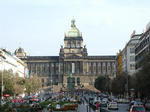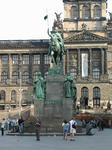 Location:
Location: Vaclavske namesti 68 (top), Underground station Museum
Phone: +420 2 24 23 04 85; lines 202, 352, 376
Open: 09.00 - 17.00
Closed: every first Tuesday in the month and on public holidays
Entrance Fees: Normal 70,- CZK, discounted 35,- CZK, Children up to 6 years free of charge. Every first Monday in the month free of charge.
The National Museum, a scientific institution intended to systematically establish, prepare and publicly exhibit natural scientific and historical collections, was founded through the efforts of many distinguished figures in Bohemia beginning as early as the end of the 18th century. Particular recognition in these endeavors is due to Kaspar Maria, Count Sternberg, who we can consider to be the main founder of the National Museum. Among the enlightened aristocracy of the land and the Czech patriotic political leaders, the specific proposals expressing Kaspar Sternberg conception found their champion in the person of the highest burgrave, Count Frantisek Libstejnsky from Kolovrat. Their public declaration from the celebratory founder's meeting on April 15th, 1818 can be understood as the founding charter of the National Museum.
In the beginning, the collections were teporarily concentrated in several locations throughout Prague. In 1819, the museum acquired its first permanent quarters in Sternberg Palace in Hradcany. After a quarter of a century in 1846, the museum moved to the relatively small Nostic Palace in Na Prikope street.
At present the National Museum shelters almost 14 million of items from the area of natural history, history, arts,  music and librarianship, located in tens of buildings. Throughout the entire year, visitors may view the permanent exhibits of the National Museum as well as a number of temporary exhibits. These are generally housed in the Hollareum exhibit hall on the ground floor of the main building as well as the two corridors leading to this space from the entrance vestibule. There are often other small exhibits in the Museum of book culture also on the ground floor before the entrance into the study room of the national Museum Library. On the first floor, three rooms across from the Pantheon are occassionally reserved for exhibits. Spacoius less extensive exhibits are presented on the second floor gallery, while in the Pantheon itself there are periodic exhibits of exceptional significance. The Pantheon is also often used for exceptional evening social events. The interior staircase of the National Museum building is a space having remarkably fine acoustics, and thus is the place of favorite traditional chamber and choral concerts.
music and librarianship, located in tens of buildings. Throughout the entire year, visitors may view the permanent exhibits of the National Museum as well as a number of temporary exhibits. These are generally housed in the Hollareum exhibit hall on the ground floor of the main building as well as the two corridors leading to this space from the entrance vestibule. There are often other small exhibits in the Museum of book culture also on the ground floor before the entrance into the study room of the national Museum Library. On the first floor, three rooms across from the Pantheon are occassionally reserved for exhibits. Spacoius less extensive exhibits are presented on the second floor gallery, while in the Pantheon itself there are periodic exhibits of exceptional significance. The Pantheon is also often used for exceptional evening social events. The interior staircase of the National Museum building is a space having remarkably fine acoustics, and thus is the place of favorite traditional chamber and choral concerts.
Permanent Exhibitions:
Prehistory of Bohemia
Moravia, Slovakia, Mineralogy and Petrology
Paleontology
Zoology
Anthropology - human bones tells a story.
 Guide
Guide 


